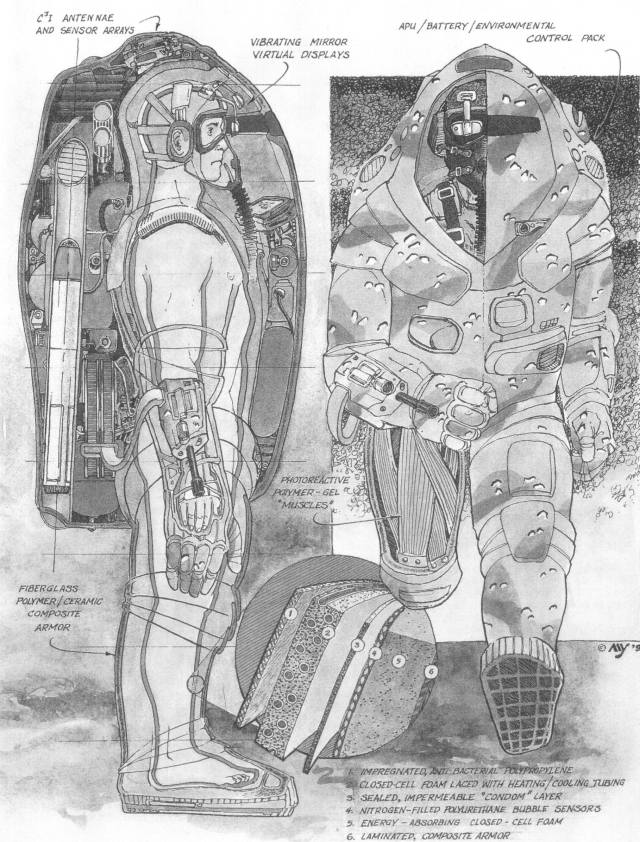
Pitman
Designed as an "enhanced special forces capability for low intensity conflicts and counterterrorists". It was conceived at Los Alamos National Laboratory by Jeff Moore of Advanced Weapons Technology Group.
The operator is housed in a 500 Lbs fiberglass, polymer/ceramic composite armor called Body Armor, Powered (BAP). Pitman is capable of carrying 300 Lbs of equipment. BAP consists of six layers: (1) Impregnated antibacterial polypropylene; (2) Closed-cell foam laced with heating/cooling tubing; (3) Sealed, impermeable "condom" layer; (4) nitrogen- filled polyurethane bubble sensors; (5) energy absorbing closed-cell foam(6) laminated, composite armor. The exoskeleton frame and joints are lightweight graphite epoxy or Kevlar. Joint structure and kinematics are still unconceptualized at this time[1994]. Photoreactive polymer-gel muscles drive the joints. Protected from 0.50 caliber armor piercing rounds, laser, thermal, nuclear, chemical and biological weapons, this 500 Lbs suit appears weightless because the polymer-gel actuators counterbalance the weight. The operator views the environment through vibrating mirror virtual displays. Mounted over his head are C3i Antennae and sensor arrays. An Auxiliary Power Unit (APU)/battery/environmental control pack provides power and cooling/heating for operator comfort.
This design marks a departure from the use of traditional actuation and joint technology. More organic in nature, this monster blends with its operator in as seamless a mechanical interface as possible. Traditional joint technology used in Hardiman and even in the Man-Amplifier may be unsuitable. Actuator control is provided by the soldier's own brain and central nervous system augmented by computers. Lining each segment a sheet of nitrogen filled polyurethane sacs (similar to bubble wrap). In addition to providing cushioning, this material senses the operator's movements and generates signals that are processed for actuation. In the ultimate system magnetoencephalographic (MEG) sensors would monitor brain activity creating a phantom central nervous system to control the polymer muscles. Hydrogen/oxygen conducting polymer fuel cells supply the power.
Although still years into the future, the Army's interest has been piqued. No doubt in time this technology will become a reality as pursues bigger and better killing machines.
(Text borrowed from Mark Rosheim's book "Robot Evolution". 1994)